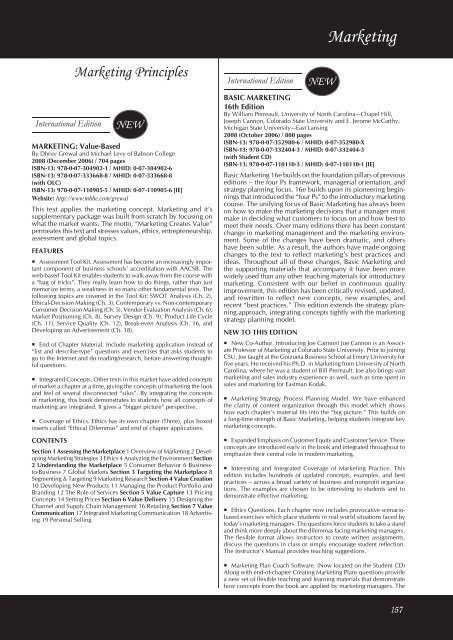Business Communication - McGraw-Hill Books
Business Communication - McGraw-Hill Books
Business Communication - McGraw-Hill Books
Create successful ePaper yourself
Turn your PDF publications into a flip-book with our unique Google optimized e-Paper software.
MarketingInternational EditionMarketing PrinciplesNEWMARKETING: Value-BasedBy Dhruv Grewal and Michael Levy of Babson College2008 (December 2006) / 704 pagesISBN-13: 978-0-07-304902-1 / MHID: 0-07-304902-6ISBN-13: 978-0-07-333668-8 / MHID: 0-07-333668-8(with OLC)ISBN-13: 978-0-07-110905-5 / MHID: 0-07-110905-6 [IE]Website: http://www.mhhe.com/grewalThis text applies the marketing concept. Marketing and it’ssupplementary package was built from scratch by focusing onwhat the market wants. The motto, “Marketing Creates Value”permeates this text and stresses values, ethics, entrepreneurship,assessment and global topics.FEATURES• Assessment Tool Kit. Assessment has become an increasingly importantcomponent of business schools’ accreditation with AACSB. Theweb-based Tool Kit enables students to walk away from the course witha “bag of tricks”. They really learn how to do things, rather than justmemorize terms, a weakness in so many other fundamental texts. Thefollowing topics are covered in the Tool Kit: SWOT Analysis (Ch. 2),Ethical-Decision Making (Ch. 3), Contemporary vs. Non-contemporaryConsumer Decision Making (Ch. 5), Vendor Evaluation Analysis (Ch. 6),Market Positioning (Ch. 8), Survey Design (Ch. 9), Product Life Cycle(Ch. 11), Service Quality (Ch. 12), Break-even Analysis (Ch. 16, andDeveloping an Advertisement (Ch. 18).• End of Chapter Material. Include marketing application instead of“list and describe-type” questions and exercises that asks students togo to the Internet and do reading/research, before answering thoughtfulquestions.• Integrated Concepts. Other texts in this market have added conceptsof market a chapter at a time, giving the concepts of marketing the lookand feel of several disconnected “silos”. By integrating the conceptsof marketing, this book demonstrates to students how all concepts ofmarketing are integrated. It gives a “bigger picture” perspective.• Coverage of Ethics. Ethics has its own chapter (Three), plus boxedinserts called “Ethical Dilemmas” and end of chapter applications.CONTENTSSection 1 Assessing the Marketplace 1 Overview of Marketing 2 DevelopingMarketing Strategies 3 Ethics 4 Analyzing the Environment Section2 Understanding the Marketplace 5 Consumer Behavior 6 <strong>Business</strong>to-<strong>Business</strong>7 Global Markets Section 3 Targeting the Marketplace 8Segmenting & Targeting 9 Marketing Research Section 4 Value Creation10 Developing New Products 11 Managing the Product Portfolio andBranding 12 The Role of Services Section 5 Value Capture 13 PricingConcepts 14 Setting Prices Section 6 Value Delivery 15 Designing theChannel and Supply Chain Management 16 Retailing Section 7 Value<strong>Communication</strong> 17 Integrated Marketing <strong>Communication</strong> 18 Advertising19 Personal SellingInternational EditionNEWBASIC MARKETING16th EditionBy William Perreault, University of North Carolina—Chapel <strong>Hill</strong>,Joseph Cannon, Colorado State University and E. Jerome McCarthy,Michigan State University—East Lansing2008 (October 2006) / 800 pagesISBN-13: 978-0-07-352980-6 / MHID: 0-07-352980-XISBN-13: 978-0-07-332404-3 / MHID: 0-07-332404-3(with Student CD)ISBN-13: 978-0-07-110110-3 / MHID: 0-07-110110-1 [IE]Basic Marketing 16e builds on the foundation pillars of previouseditions – the four Ps framework, managerial orientation, andstrategy planning focus. 16e builds upon its pioneering beginningsthat introduced the “four Ps” to the introductory marketingcourse. The unifying focus of Basic Marketing has always beenon how to make the marketing decisions that a manager mustmake in deciding what customers to focus on and how best tomeet their needs. Over many editions there has been constantchange in marketing management and the marketing environment.Some of the changes have been dramatic, and othershave been subtle. As a result, the authors have made ongoingchanges to the text to reflect marketing’s best practices andideas. Throughout all of these changes, Basic Marketing andthe supporting materials that accompany it have been morewidely used than any other teaching materials for introductorymarketing. Consistent with our belief in continuous qualityimprovement, this edition has been critically revised, updated,and rewritten to reflect new concepts, new examples, andrecent “best practices.” This edition extends the strategy planningapproach, integrating concepts tightly with the marketingstrategy planning model.NEW TO THIS EDITION• New Co-Author. Introducing Joe Cannon! Joe Cannon is an AssociateProfessor of Marketing at Colorado State University. Prior to joiningCSU, Joe taught at the Goizueta <strong>Business</strong> School at Emory University forfive years. He received his Ph.D. in Marketing from University of NorthCarolina, where he was a student of Bill Perreault. Joe also brings vastmarketing and sales industry experience as well, such as time spent insales and marketing for Eastman Kodak.• Marketing Strategy Process Planning Model. We have enhancedthe clarity of content organization through this model which showshow each chapter’s material fits into the “big picture.” This builds ona long-time strength of Basic Marketing, helping students integrate keymarketing concepts.• Expanded Emphasis on Customer Equity and Customer Service. Theseconcepts are introduced early in the book and integrated throughout toemphasize their central role in modern marketing.• Interesting and Integrated Coverage of Marketing Practice. Thisedition includes hundreds of updated concepts, examples, and bestpractices – across a broad variety of business and nonprofit organizations.The examples are chosen to be interesting to students and todemonstrate effective marketing.• Ethics Questions. Each chapter now includes provocative scenariobasedexercises which place students in real world situations faced bytoday’s marketing managers. The questions force students to take a standand think more deeply about the dilemmas facing marketing managers.The flexible format allows instructors to create written assignments,discuss the questions in class or simply encourage student reflection.The Instructor’s Manual provides teaching suggestions.• Marketing Plan Coach Software. (Now located on the Student CD)Along with end-of-chapter Creating Marketing Plans questions providea new set of flexible teaching and learning materials that demonstratehow concepts from the book are applied by marketing managers. The157HED 2007 Marketing.indd 15710/5/2006 1:42:47 PM

















